Here I will preview units and other new features or XGM-XC.
Some will be from XGM for those unfamiliar with the Extended Greek Mod, and others will be pure Extended Cultures, and I will be sure to make that distinction.
--------------------------------------------------------
First preview:
A battle between a Roman Consular army, and Carthaginian mercenary army.
(All units shown in this preview are from XGM)
Let’s introduce some of the players first.
The Romans
Velites: skirmishers and the first to make contact with the enemy, they will disrupt your enemy’s formation.

Hastati: they aren’t the best, but they are good.

Principes: they’ll hold their own against all, but the toughest of enemies.
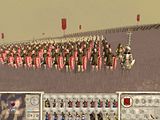
Equites: Roman cavalry drawn from the middle class,

Triarii: that the Romans had a phrase, “it has come to the Triarii” meaning “Things are desperate”, shows how good Hastati and Principes are. To say that Triarii outclass both, shows how good they are.

The Carthaginians
Libyan Light Infantry, natives of North Africa recruited into the Carthaginian armies, they are capable infantry, but don’t expect them to hold the line for long.

Numidian Cavalry, skirmisher cavalry from North Africa, a common sight among Carthaginian armies, they are excellent at breaking up enemy formations.

Libyan Spearmen, North African natives recruited by Carthage, they fight in the manner of Greek hoplites.
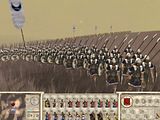
Civic Infantry, Carthaginians rarely used citizen soldiers, so these men lack the experience that their mercenary counterparts have, still their equipment is top notch.

Sacred Band, an exception to citizen soldiers is the Sacred Band, originally enlisted as officers; these elite soldiers can act as an anchor for the entire Carthaginian line.

Sacred Band Cavalry, you thought Sacred Band were tough? Try them when they are mounted.

Carthaginian Armored Elephants, elephants were used in warfare even into the 18th century, which attests to their fearsome presence on the battlefield. These are the best of the best, heavily armored and well trained; these elephants will break the line of any army.

Now for some battle highlights:
Roman slingers and archers weaken the enemy before the initial clash.
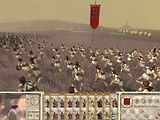

As do the Velites, once the enemy draws near.

It takes great discipline to stand in the face of charging elephants, but discipline is what the Romans are known for.

Especially when those elephants can toss a man well into the air

A unit of Sacred Band advances under fire from the Hastati.

While Triarii counter charge the elephants.
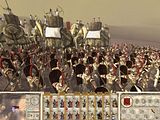
Hastati square off against Sacred Band.

Velites throw their javelins at the Armored Elephants.

Two Hastati flee a dying elephant.

A clash of elites, Triarii and Sacred Band battle it out in the shadow of the elephants.
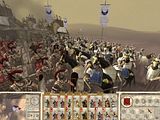
On the other end of the battle, Equites chase the Numidian cavalry.

Equites charge the Numidians while the battle rages in the background.
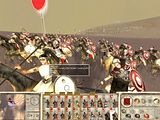
The Roman and Carthaginian generals’ guards fight.
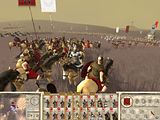
Hastati and Principes double team Iberian mercenaries.

The Sacred Band charges the Roman general.

Finally having broken the enemy, the Roman cavalry chase the Carthaginians down.
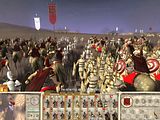
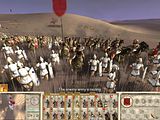
Battles are very balance in XGM-XC, this battle was close to going either way for quite a while.
----------------------------------------------------------
More units:
These are but a sampling of the many units in XGM-XC.
(All units shown in this preview are from XGM)
Legionary First Cohort, The Roman first cohort consists of well-armed and armoured infantrymen, who go into combat carrying the symbol of Roman power, a Legionary Eagle. This is inspirational for other Roman troops. Legionaries are tough, professional troops with good armour and superb weapons. Their hallmarks are discipline, obedience and tactical flexibility.

Greek Phalanx, phalangites form the backbone of Greek battle lines. Phalangites are drawn from families with decent resources, as these men need to provide leather cuirass armour and a metal helmet for protection.

Macedonian Agema Hypaspist, Agema Hypaspists are an elite within an elite. Selected from the fleetest and most agile hoplites, these men are expected to perform a variety of tasks. Each of them is equipped in similar fashion to a hoplite, but unlike hoplites, hypaspists are not equipped with thrusting spears, but instead carry a bundle of javelins and a sword.

Syracusan Hoplites, A social and military elite, Syracusan hoplites are the 'best' men of Syracuse - sons of the wealthy and politically powerful, who are freed from all other obligations to devote their time to military training. Heavily armed and armoured, they fight in the traditional hoplite style, using the weight of the phalanx and their great shields to crush enemy formations and drive them from the field.

Seleucid Argyraspid Legionaries, Argyraspid (or silver shield) Legionaries are equipped and fight in a similar fashion to Roman troops, using heavy javelins to pepper the enemy before closing to fight with short swords. Armoured from head to toe, in a similar fashion to Cataphracts, they are the heaviest of heavy infantry and make ideal shock troops. Argyraspids are the embodiment of Seleucid martial prowess. With iron discipline and unmatched weight of armour, they are capable of extraordinary feats on the battlefield.
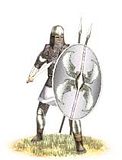
Bactrian Hoplites, Recruited from the upper ranks of the native population, and those of mixed Greek and eastern parentage, these men are trained to fight in the traditional hoplite style. Equipped with good armour and heavy spears, they are well suited to defending the flanks of the phalanx from cavalry and lighter infantry.

Spartan Royal Guard
Spartan hoplites are trained from infancy to be nothing but soldiers. They are 'perfect soldiers' and nothing else. All of Spartan life is spent training for war. The result is a man who thinks nothing of danger, expects to win, and creates a sense of dread in his opponents. By tradition the Spartan Royal Guard numbers just 300 men. Only the finest Spartan warriors are recruited to replace those who fall in battle.

Temple Guard, An elite within the Sabaean military, the men of the Temple Guard are trained to fight from birth, and sworn by religious oath to fight to the death to preserve the holy places of Saba. Armed with composite bows, and great two handed axes, they are dangerous opponents on the battlefield, able to strike from a distance, or cut a swath through enemy infantry formations.
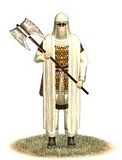
Parthian Cataphracts, Cataphracts are extremely heavily armoured cavalry who can turn a battle with one thunderous charge. They are the ultimate in shock cavalry, an armoured battering ram to crash into an enemy position and sweep aside all who stand against them. They are armed with heavy lances for the initial charge and maces for use in close combat. They wear armour that is almost unmatched for weight and protection, and their horses are similarly armoured. On the move they are a wall of metal bearing down on enemies, tipped with razor-sharp spear points.

German Chosen Axemen, Chosen Axemen are steadfast and aggressive warriors, the 'infantry of the line' for barbarian warlords. They are not very disciplined at times, as their sense of honour and bravery can make them eager to get into any fray, but they are uniformly superb fighters. Every warlord worth the name makes sure he has a couple of warbands of these hard men under his command.

Gallic Chosen Slingers, Unlike the callow youths who use the sling to skirmish around the edge of battle, these men have made the sling their profession. Years of war, and frequent service as mercenaries, have battle-hardened them and made them wealthy enough to afford good equipment. A lifetime of using the sling has also made these men among the most disciplined troops available to a barbarian warlord. These men favour stealth, ambush, and strategy. Positioned well on the battlefield, on the flank or in the rear of the enemy line, their deadly hail of bullets will devastate even the heaviest infantry.
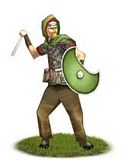
Gallic Heavy Swordsmen, Heavy Swordsmen are steadfast and aggressive warriors, the 'infantry of the line' for barbarian warlords. They are not very disciplined at times, as their sense of honour and bravery can make them eager to get into any fray, but they are uniformly superb swordsmen. Every warlord worth the name makes sure he has a couple of warbands of these hard men under his command.

Iberian Ambakaro, Among the doughty folk of the Iberian hills, the Ambakaro (‘arms bearers’) are men whose bravery, stamina and skill is unmatched. Sworn to defend their chieftain to the death, these elite fighters are shock troops who disregard all danger when cutting their enemies to pieces. Armed with heavy javelins and falcatas, and protected by round shields, and good scale armour, these men are fleet of foot but still quite capable of standing against the best heavy infantry.
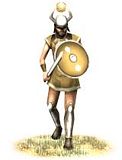
-----------------------------------------------------------
Veni, Vidi, well... you know.
Extended Cultures, A modification of RTW.
Si hoc legere posses, Latinam linguam scis.
ɪf ju kæn ɹid ðɪs, ju noʊ liŋgwɪstɪks.
Some will be from XGM for those unfamiliar with the Extended Greek Mod, and others will be pure Extended Cultures, and I will be sure to make that distinction.
--------------------------------------------------------
First preview:
A battle between a Roman Consular army, and Carthaginian mercenary army.
(All units shown in this preview are from XGM)
Let’s introduce some of the players first.
Velites: skirmishers and the first to make contact with the enemy, they will disrupt your enemy’s formation.

Hastati: they aren’t the best, but they are good.

Principes: they’ll hold their own against all, but the toughest of enemies.

Equites: Roman cavalry drawn from the middle class,

Triarii: that the Romans had a phrase, “it has come to the Triarii” meaning “Things are desperate”, shows how good Hastati and Principes are. To say that Triarii outclass both, shows how good they are.

Libyan Light Infantry, natives of North Africa recruited into the Carthaginian armies, they are capable infantry, but don’t expect them to hold the line for long.

Numidian Cavalry, skirmisher cavalry from North Africa, a common sight among Carthaginian armies, they are excellent at breaking up enemy formations.

Libyan Spearmen, North African natives recruited by Carthage, they fight in the manner of Greek hoplites.

Civic Infantry, Carthaginians rarely used citizen soldiers, so these men lack the experience that their mercenary counterparts have, still their equipment is top notch.

Sacred Band, an exception to citizen soldiers is the Sacred Band, originally enlisted as officers; these elite soldiers can act as an anchor for the entire Carthaginian line.

Sacred Band Cavalry, you thought Sacred Band were tough? Try them when they are mounted.

Carthaginian Armored Elephants, elephants were used in warfare even into the 18th century, which attests to their fearsome presence on the battlefield. These are the best of the best, heavily armored and well trained; these elephants will break the line of any army.

Now for some battle highlights:
Roman slingers and archers weaken the enemy before the initial clash.


As do the Velites, once the enemy draws near.

It takes great discipline to stand in the face of charging elephants, but discipline is what the Romans are known for.

Especially when those elephants can toss a man well into the air

A unit of Sacred Band advances under fire from the Hastati.

While Triarii counter charge the elephants.

Hastati square off against Sacred Band.

Velites throw their javelins at the Armored Elephants.

Two Hastati flee a dying elephant.

A clash of elites, Triarii and Sacred Band battle it out in the shadow of the elephants.

On the other end of the battle, Equites chase the Numidian cavalry.

Equites charge the Numidians while the battle rages in the background.

The Roman and Carthaginian generals’ guards fight.

Hastati and Principes double team Iberian mercenaries.

The Sacred Band charges the Roman general.

Finally having broken the enemy, the Roman cavalry chase the Carthaginians down.


Battles are very balance in XGM-XC, this battle was close to going either way for quite a while.
----------------------------------------------------------
More units:
These are but a sampling of the many units in XGM-XC.
(All units shown in this preview are from XGM)
Legionary First Cohort, The Roman first cohort consists of well-armed and armoured infantrymen, who go into combat carrying the symbol of Roman power, a Legionary Eagle. This is inspirational for other Roman troops. Legionaries are tough, professional troops with good armour and superb weapons. Their hallmarks are discipline, obedience and tactical flexibility.

Greek Phalanx, phalangites form the backbone of Greek battle lines. Phalangites are drawn from families with decent resources, as these men need to provide leather cuirass armour and a metal helmet for protection.

Macedonian Agema Hypaspist, Agema Hypaspists are an elite within an elite. Selected from the fleetest and most agile hoplites, these men are expected to perform a variety of tasks. Each of them is equipped in similar fashion to a hoplite, but unlike hoplites, hypaspists are not equipped with thrusting spears, but instead carry a bundle of javelins and a sword.

Syracusan Hoplites, A social and military elite, Syracusan hoplites are the 'best' men of Syracuse - sons of the wealthy and politically powerful, who are freed from all other obligations to devote their time to military training. Heavily armed and armoured, they fight in the traditional hoplite style, using the weight of the phalanx and their great shields to crush enemy formations and drive them from the field.

Seleucid Argyraspid Legionaries, Argyraspid (or silver shield) Legionaries are equipped and fight in a similar fashion to Roman troops, using heavy javelins to pepper the enemy before closing to fight with short swords. Armoured from head to toe, in a similar fashion to Cataphracts, they are the heaviest of heavy infantry and make ideal shock troops. Argyraspids are the embodiment of Seleucid martial prowess. With iron discipline and unmatched weight of armour, they are capable of extraordinary feats on the battlefield.

Bactrian Hoplites, Recruited from the upper ranks of the native population, and those of mixed Greek and eastern parentage, these men are trained to fight in the traditional hoplite style. Equipped with good armour and heavy spears, they are well suited to defending the flanks of the phalanx from cavalry and lighter infantry.

Spartan Royal Guard
Spartan hoplites are trained from infancy to be nothing but soldiers. They are 'perfect soldiers' and nothing else. All of Spartan life is spent training for war. The result is a man who thinks nothing of danger, expects to win, and creates a sense of dread in his opponents. By tradition the Spartan Royal Guard numbers just 300 men. Only the finest Spartan warriors are recruited to replace those who fall in battle.

Temple Guard, An elite within the Sabaean military, the men of the Temple Guard are trained to fight from birth, and sworn by religious oath to fight to the death to preserve the holy places of Saba. Armed with composite bows, and great two handed axes, they are dangerous opponents on the battlefield, able to strike from a distance, or cut a swath through enemy infantry formations.

Parthian Cataphracts, Cataphracts are extremely heavily armoured cavalry who can turn a battle with one thunderous charge. They are the ultimate in shock cavalry, an armoured battering ram to crash into an enemy position and sweep aside all who stand against them. They are armed with heavy lances for the initial charge and maces for use in close combat. They wear armour that is almost unmatched for weight and protection, and their horses are similarly armoured. On the move they are a wall of metal bearing down on enemies, tipped with razor-sharp spear points.

German Chosen Axemen, Chosen Axemen are steadfast and aggressive warriors, the 'infantry of the line' for barbarian warlords. They are not very disciplined at times, as their sense of honour and bravery can make them eager to get into any fray, but they are uniformly superb fighters. Every warlord worth the name makes sure he has a couple of warbands of these hard men under his command.

Gallic Chosen Slingers, Unlike the callow youths who use the sling to skirmish around the edge of battle, these men have made the sling their profession. Years of war, and frequent service as mercenaries, have battle-hardened them and made them wealthy enough to afford good equipment. A lifetime of using the sling has also made these men among the most disciplined troops available to a barbarian warlord. These men favour stealth, ambush, and strategy. Positioned well on the battlefield, on the flank or in the rear of the enemy line, their deadly hail of bullets will devastate even the heaviest infantry.

Gallic Heavy Swordsmen, Heavy Swordsmen are steadfast and aggressive warriors, the 'infantry of the line' for barbarian warlords. They are not very disciplined at times, as their sense of honour and bravery can make them eager to get into any fray, but they are uniformly superb swordsmen. Every warlord worth the name makes sure he has a couple of warbands of these hard men under his command.

Iberian Ambakaro, Among the doughty folk of the Iberian hills, the Ambakaro (‘arms bearers’) are men whose bravery, stamina and skill is unmatched. Sworn to defend their chieftain to the death, these elite fighters are shock troops who disregard all danger when cutting their enemies to pieces. Armed with heavy javelins and falcatas, and protected by round shields, and good scale armour, these men are fleet of foot but still quite capable of standing against the best heavy infantry.

-----------------------------------------------------------
Veni, Vidi, well... you know.
Extended Cultures, A modification of RTW.
Si hoc legere posses, Latinam linguam scis.
ɪf ju kæn ɹid ðɪs, ju noʊ liŋgwɪstɪks.
[This message has been edited by CaesarVincens (edited 01-30-2009 @ 10:43 AM).]
